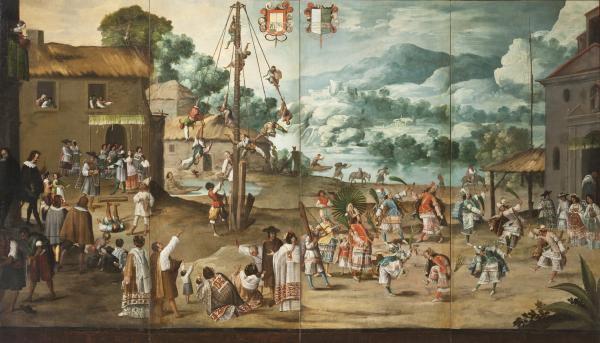The scene illustrated in this folding screen, known as a biombo in Spanish, probably took place in Santa Anita Ixtacalo, a famous destination in the southern part of present-day Mexico City. A newlywed Indian couple is shown leaving a church, and the celebration is punctuated by dynamic figures enjoying pre-Columbian games, which were still popular during the colonial period in Mexico. On the right-hand side of the screen, a group of dancers, dressed in ornate costumes, perform a mitote (or a Moctezuma dance), which imitates the dance of the legendary Aztec king. Other festivities take place throughout the scene: figures swing from a flying pole (palo volador), and a log, suspended in air, is being juggled by the feet of a performer, all to the amazement of his spectators.
An object of trade, this screen satisfied European curiosity about the New World. With its depiction of one of the most important Christian sacraments (marriage) between two Indians, this biombo proved to the colonists that their goal of religious conversion had been successful.
Folding Screen with Indian Wedding and Flying Pole (Biombo con desposorio indígena y palo volador) is currently on view on the fourth floor of the Art of the Americas Building. Check out LACMA's Collections Online to learn more about this work.
This year marks LACMA's 50th anniversary. We're celebrating all that we've done while looking forward to what's in store for us in the next 50. Check back every week on Unframed to find a highlight of an artwork from LACMA's collection, which features over 120,000 objects that span time, the globe, and all cultures. This is 13/50 of the series.



